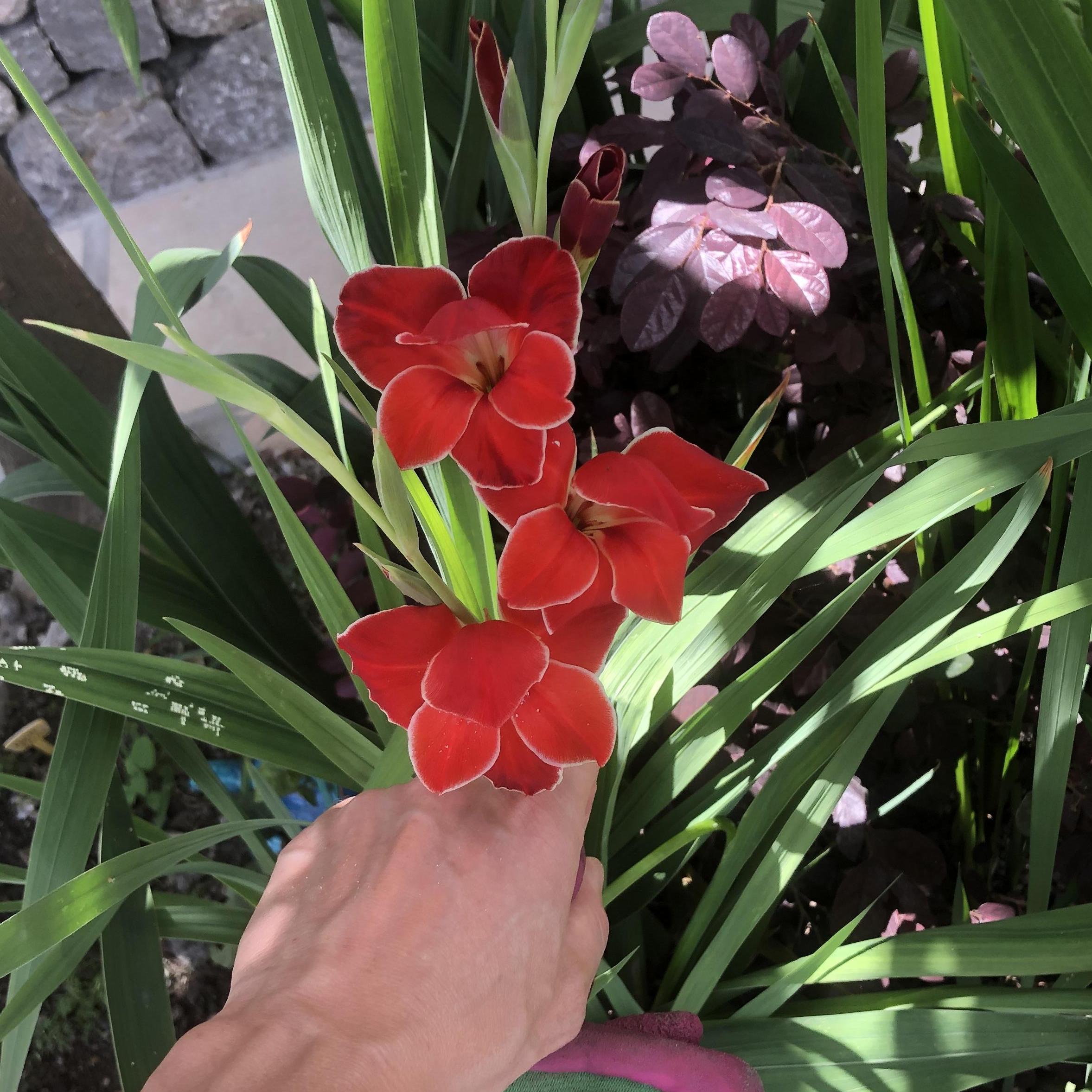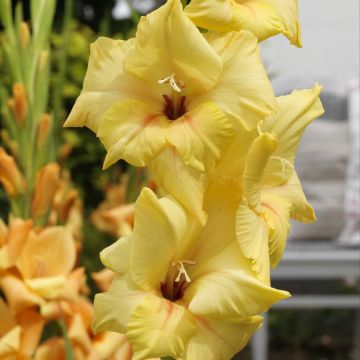

Gladiolus Addi Claudia - Sword Lily
View more pictures
Hide images

Bérengère B.

Planted last year under my lemon tree
Bérengère B. • IT
Gladiolus Addi Claudia - Sword Lily
Gladiolus x colvillei Addi Claudia ®
Colville's Gladiolus, Sword Lily
Special offer!
Receive a €20 voucher for any order over €90 (excluding delivery costs, credit notes, and plastic-free options)!
1- Add your favorite plants to your cart.
2- Once you have reached €90, confirm your order (you can even choose the delivery date!).
3- As soon as your order is shipped, you will receive an email containing your voucher code, valid for 3 months (90 days).
Your voucher is unique and can only be used once, for any order with a minimum value of €20, excluding delivery costs.
Can be combined with other current offers, non-divisible and non-refundable.
Why not try an alternative variety in stock?
View all →This plant carries a 6 months recovery warranty
More information
We guarantee the quality of our plants for a full growing cycle, and will replace at our expense any plant that fails to recover under normal climatic and planting conditions.
Would this plant suit my garden?
Set up your Plantfit profile →
Description
Gladiolus 'Claudia' is a dwarf variety that is easy to grow. It can remain in the ground during winter if protected by a good mulch. At the end of spring, it produces spikes adorned with bright red star-shaped flowers with decorative yellow streaks. With a more natural appearance than the classic tall hybrids that can look a bit stiff, this variety easily integrates into a mixed border. It looks wonderful alongside perennials or low-growing bushes.
The gladiolus genus belongs to the Iridaceae family, which mainly includes herbaceous plants such as crocus, iris, ixia, and crocosmia. There are over 260 botanical species of gladiolus, the majority of which are native to South Africa and tropical Africa. There are numerous hybrids and horticultural varieties divided into three main groups: Grandiflorus (large-flowered), Primulinus (early-flowering), and Nanus (butterflies).
Gladiolus x colvillei, obtained in England in 1823, is the first known cultivated hybrid resulting from the cross-breeding of G. cardinalis from South Africa, where it grows on damp cliffs and near waterfalls, and G. tristis, also from the same origin but with a lower habit.
'Claudia' is a highly ornamental and floriferous variety, reaching a height of no more than 50 to 60cm (20 to 24in), with a width of about 20cm (8in). This perennial herbaceous plant forms dark green thin leaves that resemble swords (gladiolus gets its name from the shape of its sword-like leaves, derived from the Latin word gladius). From June onwards, floral spikes appear above the foliage, bearing floral buds arranged alternately to the right and left. These flower stalks are adorned with 6 to 10 buds that open into flowers composed of six tepals, meaning three petals and three sepals that are essentially of the same appearance, although their dimensions may vary slightly. The three upper ones are a uniform scarlet red, while those in the lower part are ornamented with a central yellow stripe that stands out against the red background. The bright red flowers harmonise perfectly with its green foliage, creating an attractive scene for two to three months. Measuring about 6cm (2in) in diameter, the flowers express undeniable grace and romantic charm. The storage organ, called a corm, is a pseudo-bulb, which is a swollen stem with scales. Each corm produces two or three flower spikes. It prefers a sunny exposure and moist but well-drained soil.
It is easy to grow and requires no staking. The corms can remain in the ground during winter. Although of modest size, its bright red blooms capture all eyes. It can be grown in a pot on a patio or balcony. It is also easy to integrate into a mixed border. Create a romantic scene by planting it with the Nozomi ground cover rose, with its single wild rose-like flowers in pearly white and pink. For a more striking combination, choose the 'Double Punch Gold' shrubby cinquefoil, a charming small bush with finely cut foliage that is covered in vibrant yellow double flowers throughout summer. Alchemilla 'Thriller' will also be a good companion, with its unique foliage on which raindrops form like pearls, and its airy summer flowering in a sulphur yellow.
Plant habit
Flowering
Foliage
Botanical data
Gladiolus
x colvillei
Addi Claudia ®
Iridaceae
Colville's Gladiolus, Sword Lily
Cultivar or hybrid
Other Gladioli
View all →Planting and care
Choose a sunny position. 'Claudia' loves rich, fertile, well-drained soils. Sandy and loamy soil is ideal. It dreads compact clay. Avoid using manure to fertilise the soil as it causes bulb rot. Plant the corms 8 to 10cm (3 to 4in) deep, spaced 10 to 15cm (4 to 6in) apart. Water regularly during its growth and flowering period. The corms appreciate being dry during the resting period. The corms of this variety can overwinter in the ground, in well-drained, healthy soil, covered with a thick mulch to prevent damage from severe frosts. In very cold regions, dig up the plants as soon as the leaves have yellowed. Store the corms in turf and keep them dry, protected from heat and frost.
The corms can also be grown in pots, which can be protected indoors over winter. Plant 20 corms per 20 to 22cm (8 to 9in)) pot.
Planting period
Intended location
Care
Planting & care advice
This item has not been reviewed yet - be the first to leave a review about it.
Haven't found what you were looking for?
Hardiness is the lowest winter temperature a plant can endure without suffering serious damage or even dying. However, hardiness is affected by location (a sheltered area, such as a patio), protection (winter cover) and soil type (hardiness is improved by well-drained soil).

Photo Sharing Terms & Conditions
In order to encourage gardeners to interact and share their experiences, Promesse de fleurs offers various media enabling content to be uploaded onto its Site - in particular via the ‘Photo sharing’ module.
The User agrees to refrain from:
- Posting any content that is illegal, prejudicial, insulting, racist, inciteful to hatred, revisionist, contrary to public decency, that infringes on privacy or on the privacy rights of third parties, in particular the publicity rights of persons and goods, intellectual property rights, or the right to privacy.
- Submitting content on behalf of a third party;
- Impersonate the identity of a third party and/or publish any personal information about a third party;
In general, the User undertakes to refrain from any unethical behaviour.
All Content (in particular text, comments, files, images, photos, videos, creative works, etc.), which may be subject to property or intellectual property rights, image or other private rights, shall remain the property of the User, subject to the limited rights granted by the terms of the licence granted by Promesse de fleurs as stated below. Users are at liberty to publish or not to publish such Content on the Site, notably via the ‘Photo Sharing’ facility, and accept that this Content shall be made public and freely accessible, notably on the Internet.
Users further acknowledge, undertake to have ,and guarantee that they hold all necessary rights and permissions to publish such material on the Site, in particular with regard to the legislation in force pertaining to any privacy, property, intellectual property, image, or contractual rights, or rights of any other nature. By publishing such Content on the Site, Users acknowledge accepting full liability as publishers of the Content within the meaning of the law, and grant Promesse de fleurs, free of charge, an inclusive, worldwide licence for the said Content for the entire duration of its publication, including all reproduction, representation, up/downloading, displaying, performing, transmission, and storage rights.
Users also grant permission for their name to be linked to the Content and accept that this link may not always be made available.
By engaging in posting material, Users consent to their Content becoming automatically accessible on the Internet, in particular on other sites and/or blogs and/or web pages of the Promesse de fleurs site, including in particular social pages and the Promesse de fleurs catalogue.
Users may secure the removal of entrusted content free of charge by issuing a simple request via our contact form.
The flowering period indicated on our website applies to countries and regions located in USDA zone 8 (France, the United Kingdom, Ireland, the Netherlands, etc.)
It will vary according to where you live:
- In zones 9 to 10 (Italy, Spain, Greece, etc.), flowering will occur about 2 to 4 weeks earlier.
- In zones 6 to 7 (Germany, Poland, Slovenia, and lower mountainous regions), flowering will be delayed by 2 to 3 weeks.
- In zone 5 (Central Europe, Scandinavia), blooming will be delayed by 3 to 5 weeks.
In temperate climates, pruning of spring-flowering shrubs (forsythia, spireas, etc.) should be done just after flowering.
Pruning of summer-flowering shrubs (Indian Lilac, Perovskia, etc.) can be done in winter or spring.
In cold regions as well as with frost-sensitive plants, avoid pruning too early when severe frosts may still occur.
The planting period indicated on our website applies to countries and regions located in USDA zone 8 (France, United Kingdom, Ireland, Netherlands).
It will vary according to where you live:
- In Mediterranean zones (Marseille, Madrid, Milan, etc.), autumn and winter are the best planting periods.
- In continental zones (Strasbourg, Munich, Vienna, etc.), delay planting by 2 to 3 weeks in spring and bring it forward by 2 to 4 weeks in autumn.
- In mountainous regions (the Alps, Pyrenees, Carpathians, etc.), it is best to plant in late spring (May-June) or late summer (August-September).
The harvesting period indicated on our website applies to countries and regions in USDA zone 8 (France, England, Ireland, the Netherlands).
In colder areas (Scandinavia, Poland, Austria...) fruit and vegetable harvests are likely to be delayed by 3-4 weeks.
In warmer areas (Italy, Spain, Greece, etc.), harvesting will probably take place earlier, depending on weather conditions.
The sowing periods indicated on our website apply to countries and regions within USDA Zone 8 (France, UK, Ireland, Netherlands).
In colder areas (Scandinavia, Poland, Austria...), delay any outdoor sowing by 3-4 weeks, or sow under glass.
In warmer climes (Italy, Spain, Greece, etc.), bring outdoor sowing forward by a few weeks.




















































